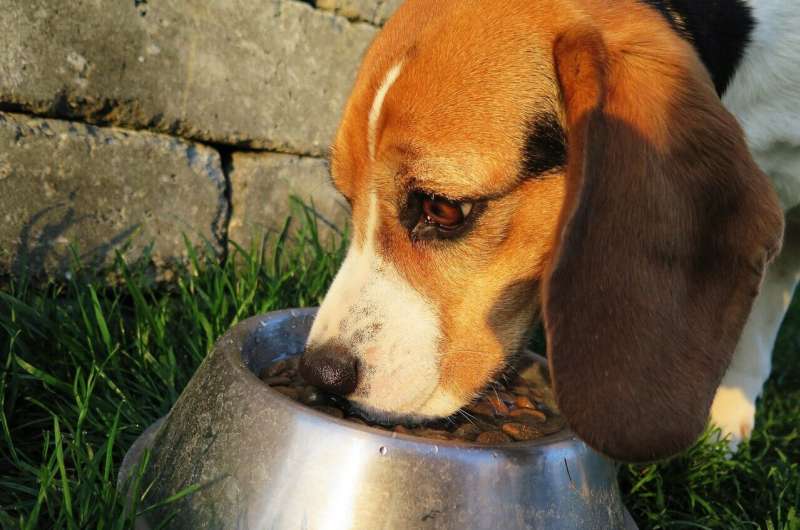This article has been reviewed according to Science X's editorial process and policies. Editors have highlighted the following attributes while ensuring the content's credibility:
fact-checked
peer-reviewed publication
trusted source
proofread
Dogs may be at risk from high levels of lead from shotgun pellets in raw pheasant dog food, study finds

Lead is a toxic metal that negatively affects body systems of people and animals, with the nervous system being particularly sensitive. Although elevated levels of dietary lead are potentially damaging to animal health, lead shot can be legally used for hunting terrestrial gamebirds, like pheasants, in the UK. While most pheasants are eaten by people, some are used in petfood.
Cambridge researchers analyzed 90 samples taken from three raw pheasant dog food products bought in the UK and found that 77% of samples had lead concentrations exceeding the maximum residue level (MRL) permitted in animal feed according to law. Mean lead concentrations of the three products were approximately 245, 135 and 49 times higher than the MRL.
The results are published today in the journal Ambio.
"We were already aware that lead concentrations in pheasant meat sold for human consumption are often far higher than would be permitted in other meats like chicken, beef or pork" said lead author Professor Debbie Pain of Cambridge's Zoology Department. "However, we were surprised to find that lead concentrations in raw pheasant dog food products were so much higher"
The mean lead concentration in the raw pheasant dog food analyzed was 34 times higher than that recently reported in pheasant meat sold for people to eat, which itself is considered to be too high. Researchers say this could be because raw pheasant meat is normally minced when used for dogfood whereas whole birds or pheasant breasts are generally sold for human consumption. Mincing may fragment lead shot, increasing the number of small lead particles in the meat and the potential for lead to be absorbed into the bloodstream.
The researchers say that dogs eating food with such high concentrations of lead, especially if they are fed on it frequently or as their main diet, are at risk of harm to their health. Puppies are particularly vulnerable both because young animals tend to absorb more of the lead they swallow than full-grown animals, and the developing nervous system is particularly affected by lead.
The scientists tested five pheasant-based dog food products. Three of these were raw meat products, one was a dried pheasant and partridge product, and one was a processed tinned pheasant and goose-based product. Three equivalent chicken-based petfood products (raw meat, dried and processed) were also assessed.
In addition to the raw pheasant dog food, levels of lead above the MRL were identified in some samples of the dried pheasant-based product, although the mean concentration was far lower than in the raw products. None of the samples from the chicken-based products or the tinned pheasant and goose-based product contained unacceptable levels of lead.
The popularity of raw meat diets for pets is increasing across the UK—a nation which is home to an estimated 13 million dogs and 12 million cats. The researchers found that raw dog food including pheasant meat was widely available in the UK. Raw pheasant pet food was sold by 34% of the 50 online raw pet food suppliers they checked—71% of these stated that the meat may contain shot.
"The fact that most samples from three randomly sampled raw pheasant pet food products had very high lead concentrations, and that our recent research on shot types used to kill pheasants found that 94% are shot with lead, suggests that this is a far broader issue than for just these three products," said co-author Professor Rhys Green. "However, some producers may source pheasants that have not been shot with lead, and owners could ask about this when buying pet food."
The study of shot types in pheasants sold for human consumption is part of a body of research assessing the effectiveness of a voluntary ban in the UK on lead shotgun ammunition to shoot wild quarry, which is being phased in over a five-year period from February 2020. Nine major shooting organizations committed to this, for sustainability reasons, considering wildlife, the environment and also to ensure a market for the healthiest game products.
Cambridge scientists have consistently found compliance with the voluntary ban to be low, which is in line with other studies investigating other voluntary bans. However, a total ban in Denmark has been shown to be very effective.
A ban on the sale and use of lead gunshot, along with restrictions on lead bullets, is currently being considered under the UK REACH Chemicals Regulation.
More information: D. Pain, Lead concentrations in commercial dogfood containing pheasant in the UK, Ambio (2023). DOI: 10.1007/s13280-023-01856-x
Journal information: AMBIO
Provided by University of Cambridge




















